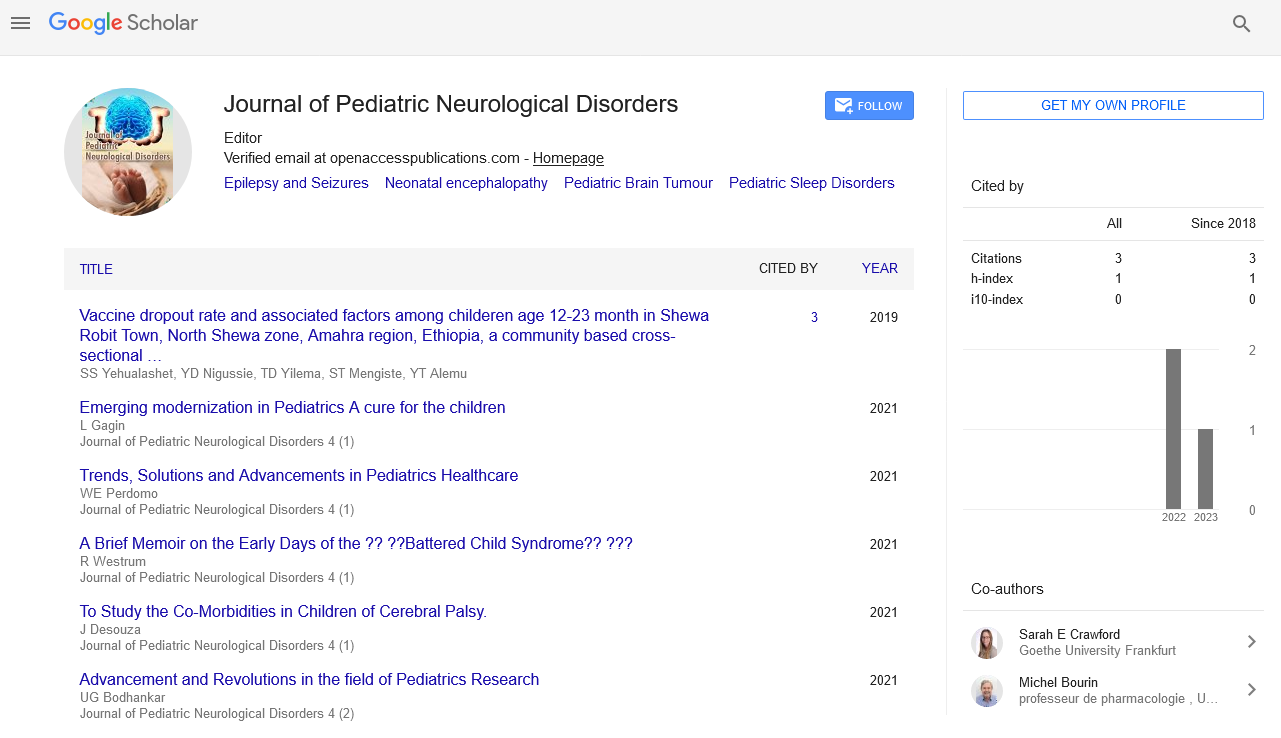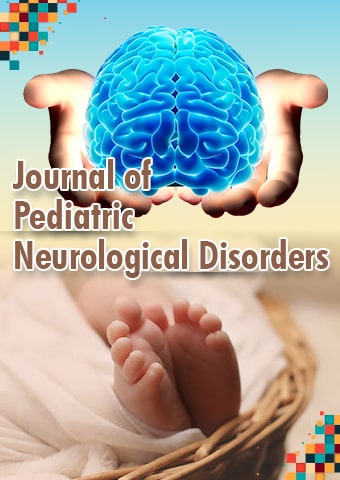Review Article - Journal of Pediatric Neurological Disorders (2023) Volume 6, Issue 1
Children's Cyclic Vomiting Syndrome
Erina Karol*
Department of Neonatal Care, University of Toronto, Canada
Department of Neonatal Care, University of Toronto, Canada
E-mail: karol127@gmail.com
Received: 1-Feb-2023, Manuscript No. pnn-23-90014; Editor assigned: 2-Feb-2023, PreQC No. pnn-23-90014 (PQ); Reviewed: 15-Feb-2023, QC No. pnn-23-90014; Revised: 21-Feb-2023, Manuscript No. pnn-23-90014(R); Published: 28-Feb-2023, DOI: 10.37532/pnn.2023.6(1).09-11
Abstract
An underdiagnosed episodic syndrome, Cyclic Vomiting Syndrome (CVS) is characterized by frequent hospitalizations, multiple comorbidities, and poor quality of life. Due to the absence of confirmatory testing and the overlooked pattern of recurrence, it is frequently misdiagnosed. Although cases of CVS have also been reported in infants and the elderly, the majority of cases occur in children or young adults. Although the etiopathogenesis is unknown for the most part, it is likely multifactorial. Abnormal brain-gut pathways, mitochondrial enzymopathies, disorders of gastrointestinal motility, abnormalities in calcium channels, and hyperactivity of the hypothalamic-pituitary-adrenal axis in response to a triggering environmental stimulus are all implicated, according to recent research. CVS is portrayed by intense, generalized and repetitive episodes of extreme sickness and incoercible retching with unsurprising periodicity and return to standard wellbeing between episodes. Clinicians face difficulties distinguishing themselves from other differential diagnoses. In all children with CVS, baseline testing to identify organic causes is recommended, but extensive and invasive investigations should be avoided. CVS management necessitates individualized treatment. The primary focus of acute phase management is supportive and symptomatic care. During the brief prodromal phase, early intervention with abortive agents can be used to try to stop the attack. Non-pharmacologic measures like altering one’s lifestyle and employing reassuring and anticipatory guidance appear to be effective as preventative treatments during the interictal period.
Keywords
Anti Emetics • Cyclic vomiting syndrome • Differential diagnosis • Episodic syndromes • Migraine
Introduction
Acute, stereotyped, and recurrent episodes of intense nausea with incoercible vomiting that last from a few hours to a few days are signs of Cyclic Vomiting Syndrome (CVS);Although the clinical presentation and natural history are somewhat influenced by age, the affected population includes both children and adults . Heberden and Gee first described CVS in the St. Bartholomew’s Hospital Reports in 1806. CVS has been considered a migraine-related or migraine-equivalent disorder due to the fact that most pediatric CVS patients develop migraines later in life, the effectiveness of anti-migraine therapy, and the observation of mitochondrial DNA polymorphisms in CVS and migraine patients. SVC is categorized as one of the episodic syndromes that may be associated with migraine in the International Classification of Headache Disorders (ICHD III beta). CVS was included in the most recent Rome IV Criteria as one of the “functional gastrointestinal disorders” (FGID), which are idiopathic disorders of the gut-brain interaction that affect various parts of the gastrointestinal tract and cause symptoms that are not organic in origin [1].
Discussion
Pathophysiology
Although a number of possible underlying mechanisms have been suggested, the pathophysiology of CVS has not yet been established. The emetic reflex is extremely intricate, and its central mechanisms and final common pathway have not yet been fully understood. It is generally agreed upon that a number of nuclei in the medulla oblongata that are situated between the obex and the rostral portion of the nucleus ambiguous play a significant part in the central coordination of emetic neurocircuitry . The Nucleus Tractus Solitarius (NTS) within the Dorsal Vagal Complex (DVC) is the primary integrative site for modulating the emetic reflex. These nuclei are collectively regarded as a central pattern generator. Via the vagus nerve, the vestibular system, and higher brain regions such as the cerebral cortex, hypothalamus, cerebellum, and the Area Postrema (AP), inputs from the gastrointestinal tract and other visceral organs are used to activate NTS in order to elicit vomiting. The latter, known as the Chemoreceptor Trigger Zone (CTZ), is an essential component of the emetic arc. It is situated outside of the Blood Brain Barrier in the floor of the fourth ventricle and has the potential to detect circulating toxins. The visceral and somatic motor events of vomiting are coordinated by activating nuclei in the hindbrain precisely synchronized with time thanks to distinct neural input from NTS. The parabrachial nucleus, hypothalamus, limbic system, and forebrain are among the higher CNS centers to which NTS has reciprocal direct or indirect projections. These centers provide the neuroanatomical substrate for the integration of various sensory, affective, and emotional responses to nausea and vomiting [2, 3].
Diagnosis
The term “URGENTIME” can be used to describe seven distinct disorders: Gastrointestinal, endocrine, neurologic, urologic, gastrointestinal, and metabolic diseases, as well as toxins and medications. Specifically, renal colic and/ or obstruction of the pelvic-ureteric junction can lead to recurrent urologic vomiting with the possibility of symptom-free intervals. Recurrent vomiting can be caused by a number of gastrointestinal conditions, including food allergy, eosinophilic esophagitis, gastritis, duodenitis, hepatitis, biliary tract dysmotility, pancreatitis, pancreatic pseudocyst, appendicitis, peptic disease, and inflammatory bowel disease. Other conditions include malrotation with volvulus, duplication cyst, and intermittent intestinal intus [4].
Children who present with vomiting should also be evaluated for diabetes, Addison’s disease, pheochromocytoma, and other neurological conditions (such as epilepsy, migraine, autonomic nervous system disorders, and brain tumor). Additionally, medications such as antibiotics, Nonsteroidal Anti-Inflammatory Drugs (NSAIDs), laxatives, and hormones must be avoided. Additionally, vomiting may be a sign of recurrent infections like enteritis, hepatitis, otitis media, and chronic sinusitis.
Lastly, aminoaciduria, organic aciduria, defects in the urea cycle and fatty acid oxidation, mitochondrial disorders, and acute intermittent porphyria should all be ruled out [5].
Symptoms
Abdominal pain and intermittent vomiting
Porphyrias are IEMs because there is a problem with how heme is made, which is what makes cytochromes and hemoglobin. All three of the most common acute intermittent porphyrias, variegate and hereditary coproporphyria, cause diffuse crampy abdominal pain and constipation. Increased activity in the first step of porphyrin synthesis causes acute neurovisceral symptoms, which can be exacerbated by certain medications. Similar to diabetic ketoacidosis, the abdominal pain may be intense. Urine has a distinctive red (or dark) color due to striking accumulations and excessive excretion of heme pathway intermediates and their oxidized products. Hepatic porphyrias are passed down through autosomal dominant inheritance. A positive Wilson Schwarts Test (urine screening test) may only be present during an acute illness, making diagnosis frequently challenging. The most effective method for diagnosis is genetic analysis, followed by simultaneous examination of blood, urine, and stool for porphyrins [6, 7].
Symptoms of Hepatitis
Galactosemia, Hereditary Fructose Intolerance (HFI), and Tyrosinaemia type I are the most common conditions in this group that cause vomiting and necessitate immediate and specific treatment for acute liver failure. Acute deterioration, vomiting, seizures, dehydration, hypoglycemia, liver failure, and tubulopathy may occur in patients. Mellituria, hyperammonaemia, hyperlactatemia, hypoglycaemia, hypertyrosinaemia, and hypermethioninaemia are additional biochemical abnormalities associated with liver disease. Tyrosinaemia type I typically manifests after the third week of life, whereas galactosaemia typically manifests during the newborn period and HFI after weaning due to the absence of fructose in infant formula. Galactose, fructose, and proteins must be avoided from the diet of the person suspected of having one of these conditions until the diagnosis is confirmed. Proteins can be reintroduced after confirmation of galactosaemia or HFI [8].
Conclusion
In 1882, Dr. Samuel Gee wrote the first description of CVS, which read: These cases appear to be of the same kind, with episodes of vomiting that come back after varying lengths of time. There are no symptoms of disease in the intervals themselves. His observations were later incorporated into Wyllie and Schlesinger’s 1933 definition of “the periodic syndrome of childhood.” At least four intense bouts of vomiting per hour are now considered to be typical of CVS, which is characterized by stretches of health that last from hours to days. The recently established diagnostic criteria have made CVS recognition easier, but many patients are still misdiagnosed. Additionally, there are no specific CVS diagnostic tests available at this time. Consequently, CVS is currently categorized as an idiopathic disorder, and the fulfillment of clinical criteria is required for diagnosis [9, 10].
Acknowledgement
None
Conflict of Interest
None
References
- Benninga MA, Faure C, Hyman PE et al. Childhood functional gastrointestinal disorders: neonate/toddler. Gastroenterology.130, 1519-1526 (2016).
- Hyams JS, Di Lorenzo C, Saps M et al. Functional disorders: children and adolescents. Gastroenterology. 150, 1456-1468 (2016).
- Doi.Brezin F, Wiedemann A, Feillet F. Cyclic vomiting syndrome in children. Arch Pediatr. 24, 1129–1136(2017).
- Hornby PJ. Central neurocircuitry associated with emesis. Am J Med. 111, S106-S112 (2001).
- Sanger GJ, Andrews PLR. Treatment of nausea and vomiting: gaps in our knowledge. Autonom Neurosci. 129, 3-16 (2006).
- Kaul A, Kaul KK. Cyclic vomiting syndrome: a functional disorder. Pediatr Gastroenterol Hepatol Nutr. 18, 224-229 (2015).
- Anderson KE, Bloomer JR, Bonkovsky HL et al. Recommendations for the diagnosis and treatment of the acute porphyrias. Ann Intern Med. 142, 439-50 (2005).
- Demirbas D, Brucker WJ, Berry GT. Inborn errors of metabolism with hepatopathy: metabolism defects of galactose, fructose, and tyrosine. Pediatr Clin North Am. 65, 337-352 (2018).
- Clayton PT. Inborn errors presenting with liver dysfunction. Semin Neonatol. 7, 49-63 (2002).
- Lund AM, Christensen E, Skovby F. Diagnostik og akut behandling af arvelige stofskiftesygdomme hos spaedbørn [Diagnosis and acute treatment of inborn metabolic diseases in infants]. Ugeskr Laeger. 164, 5613-5619 (2002).
Indexed at, Google Scholar, Crossref
Indexed at, Google Scholar, Crossref
Indexed at, Google Scholar, Crossref
Indexed at, Google Scholar, Crossref
Indexed at, Google Scholar, Crossref
Indexed at, Google Scholar, Crossref
Indexed at, Google Scholar, Crossref
Indexed at, Google Scholar, Crossref

